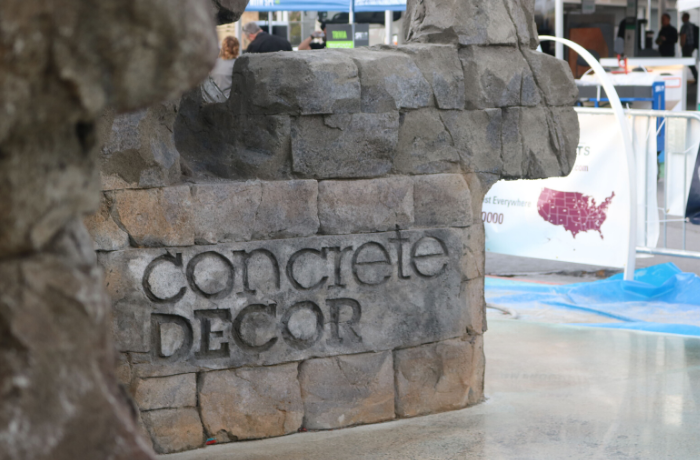 After 10 years in the trades, I decided to take my business education and trade skills in a new direction. I started a trade magazine called PaintPRO. For nearly eight years, that magazine catered to the needs of a nationwide community of painting and decorating contractors. And while big box stores were quickly changing the culture of that trade with mergers and acquisitions, I discovered an emerging trade that was equally intriguing to me. People referred to it as decorative concrete.
After 10 years in the trades, I decided to take my business education and trade skills in a new direction. I started a trade magazine called PaintPRO. For nearly eight years, that magazine catered to the needs of a nationwide community of painting and decorating contractors. And while big box stores were quickly changing the culture of that trade with mergers and acquisitions, I discovered an emerging trade that was equally intriguing to me. People referred to it as decorative concrete.
By the way, this blog isn’t an attempt to ink out some recognition for myself by way of some biographical account. There’s an important message in this blog that I feel underlies everything we do in this building trade today.
The growing attraction of decorative concrete
There is a reason decorative concrete attracts people from a multitude of other trades and environments. It’s cool, for sure, it’s in demand and it’s everywhere. Having published Concrete Decor for going on 20 years offers some testimony to the fact that products are of good quality but those products, in the hands of skilled applicators, is where we can continue to excel or fail miserably.
As decorative concrete continues to be the choice for a myriad of building applications, contractors doing this work need more than simple instructions on how to use a product. I believe everyone needs that special voice inside their head. And sometimes that voice even yells loudly within our minds whenever something has the potential to go wrong or is already going wrong.
When Concrete Decor started, most of the people I met hailed from other trades, including myself. They seemingly all had established skills that made it easy for them to adapt to and learn new products. However, fast-forward 20 years, and one of two changes is now occurring. Decorative concrete is either developing its own set of trade skills or it’s slowly losing sight of the importance and need for fundamental skills as a criterion for success.
But, is decorative concrete a trade?
Some may question if decorative concrete is a trade. However, I’d likely be among the first to counter with a question. That question asks if decorative concrete could survive if it weren’t for the many intersecting parts.
In other words, would we be as advanced in the ways concrete stains are applied to concrete, overlayments, polished concrete, tilt-up construction or countertops, if a painter, an artist, a concrete contractor, a flooring contractor or even a mason were not able to connect with one another in decorative concrete? An even better question might ask whether these skills can benefit future generations if they aren’t tied to a fundamental source that was established in decorative concrete.
Online videos won’t cut it
Just the other day, I watched a short YouTube video on getting a vertical carving mix to stick to a scratch coat. What struck me as an immediate concern was the fact that vertical mixes follow the basic rules of stucco and plastering applications. The tip didn’t include any mention of a starting point on the wall surface. It also did not mention the use of a bonding agent or how to apply a scratch coat. The video also left out the proper use of lath and fasteners or fastener placements. It even left out a vapor barrier or even tools necessary to achieve an approved finish.
Regardless of what kind of finish a customer may agree on, ensuring that the product lasts is crucial. This is a problem with online videos. This is because YouTube doesn’t discriminate between those who are experts in a trade and those who aren’t. There are critical steps we must honor to do any type of work proficiently. Unless there are fundamentals underscoring every type of product application, we can’t ensure that contractors perform a specific type of work proficiently or productively in this trade.
Decorative concrete, the outstanding imitator
Decorative concrete, in my opinion, isn’t as much about being an originator as it is about being an outstanding imitator. After all, we’re often trying to make concrete look like something natural. This is bacause more times than not, unnatural just doesn’t sell.
The last thing any of us wants to hear is that voice inside our head constantly yelling at us because that instructor, who tried to teach us the right way to do things, is still passionately striving to serve their trade right instilling in us the skills someone afforded to them!
We need more teachers
Decorative concrete needs more teachers. While there are plenty of people who can teach us how to use a product, trade skills are taught on job sites by contractors who employ men and women to do a specific type of work for them. Trade skills enable us to understand the when, where, how and why a product is the best choice for a building application.
Decorative concrete, like other successful trades, requires a community of people. This group must understand the importance of fundamentals and aren’t willing to deviate from those standards. Trades are taught on job sites by contractors who recognize their trade as a trade first, a business opportunity second and responsibility to training others throughout the life of their business as fundamental.
If we can agree that contractors are an industry’s front line of defense, then we can also agree that industry success requires everyone to be working collectively toward their ongoing success.
You might be thinking to yourself, YEAH! … good luck with that! But, if anything I’m saying here touches a chord with you, it should be worthwhile to start talking about it at sales meetings. Or maybe you should discuss it over a beer with key customers. They are the ones who are actually making a difference with programs they’ve implemented. I might add that this is where product sales become a by-product of hard-working business relationships.
My next blog will attempt to identify what an industry working together may look like. It will also discuss what it can accomplish when all of its parts are working together.















